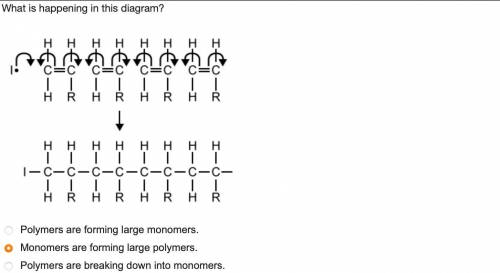
What is happening in this diagram?
4 iterations of the following structure: 2 carbons double bonded to each other, each bonded to H above, the left C bonded to H below and the right to R below. The chain begins with an I and a dot. A curved arrow points from the dot to the space before the first structure above; curved arrows point left and right from the double bonds to the spaces before and after the structures. Arrow points to a long chain of carbons, I at the beginning of the chain. The carbons are all bonded to H above, and alternate bonding to H and R below.
Polymers are forming large monomers.
Monomers are forming large polymers.
Polymers are breaking down into monomers.
Monomers are breaking down into polymers.
ANSWER:
Monomers are forming large polymers.

Answers: 2


Another question on Chemistry

Chemistry, 21.06.2019 19:00
Dying the folding patterns of protein molecules can microbiologists better understand cellular processes as well as some diseases, such as alzheimer’s, that are caused by proteins that have misfolded. the folding of these complicated molecules can be simulated on computers, but it takes a lot of processor power and time for even expensive supercomputers to do this. a group of researchers at stanford university developed software that can be used to distribute the processing of data to anyone who is willing to donate time on their idle personal computers. as a result, the researchers have been able to achieve protein-folding simulations that are far better than those other computing methods have done. which statement best describes the work of these researchers? the work is not scientific because the data are not processed in one location. the work is not scientific because the simulations are not reproducible. the researchers applied creativity to solve a problem in running an experiment. the researchers used only well-established scientific techniques.
Answers: 3

Chemistry, 22.06.2019 00:00
What stress will shift the following equilibrium system to the left? n2(g) + 3h2(g) ⇌ 2nh3(g) adding more n2(g) adding more nh3(g) increasing the pressure of the system reducing the volume of the container
Answers: 1

Chemistry, 22.06.2019 07:30
Calculate the ratio of h+ ions to oh– ions at a ph = 7. find the concentration of h+ ions to oh– ions listed in table b of your student guide. then divide the h+ concentration by the oh– concentration. record this calculated ratio in table a of your student guide. compare your approximated and calculated ratios of h+ ions to oh– ions at a ph = 7. are they the same? why or why not? record your comparison in table a. what is the concentration of h+ ions at a ph = 7? mol/l what is the concentration of oh– ions at a ph = 7? mol/l what is the ratio of h+ ions to oh– ions at a ph = 7? : 1
Answers: 1

Chemistry, 22.06.2019 09:00
This chart lists four kinds of polymers and their sources. what can be known about all four polymers, despite their differences? they come from living things. they share ionic carbon bonds. they are at least 100 monomers long. they are made of repeating subunits.
Answers: 2
You know the right answer?
What is happening in this diagram?
4 iterations of the following structure: 2 carbons double bonded...
Questions


English, 09.01.2020 10:31

Arts, 09.01.2020 10:31


History, 09.01.2020 10:31


Mathematics, 09.01.2020 10:31



English, 09.01.2020 10:31


Mathematics, 09.01.2020 10:31

Mathematics, 09.01.2020 10:31


Biology, 09.01.2020 10:31








